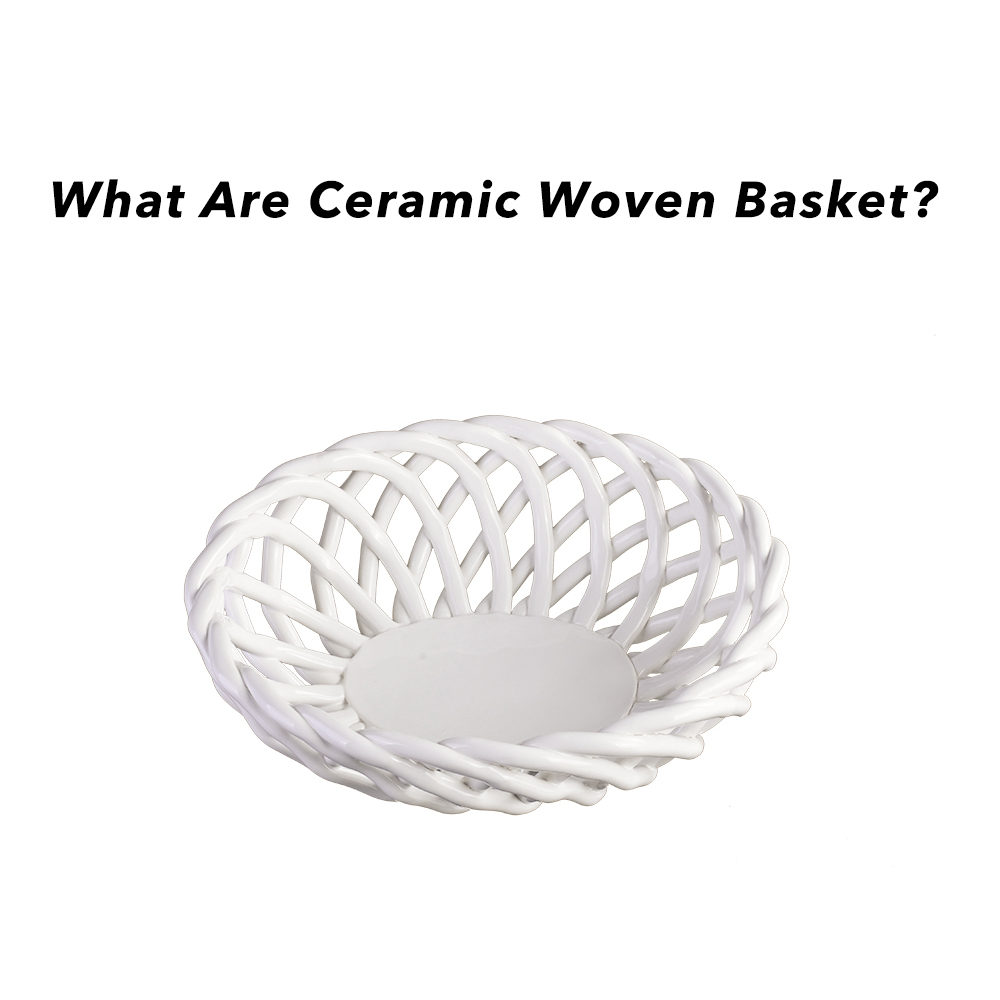What Are Ceramic Woven Basket?
Time of issue: 2024-03-22 11:37:53
Introduce:
Ceramic woven baskets offer a unique and artistic twist on traditional basketry, blending the timeless appeal of woven designs with the durability and versatility of ceramic materials. These beautifully crafted pieces add a touch of elegance and sophistication to any space, serving both functional and decorative purposes. In this article, we'll explore the allure of ceramic woven baskets, delving into their construction, uses, and aesthetic appeal.
What Is The History Of Baskets?
According to WIKI. The oldest known baskets were discovered in Faiyum in upper Egypt and have been carbon dated to between 10,000 and 12,000 years old, earlier than any established dates for archaeological evidence of pottery vessels, which were too heavy and fragile to suit far-ranging hunter-gatherers.
How are Ceramic Woven Basket Made?
Ceramic woven baskets are exquisite pieces of artistry that combine the timeless appeal of traditional basket weaving with the durability and versatility of ceramic materials. Handcrafted with precision and skill, these baskets are not only functional but also serve as stunning decorative accents in any home. In this article, we'll take a detailed look at the intricate process of making ceramic woven baskets, from the initial preparation of materials to the final firing in the kiln.
Preparing the Clay:
The process of making ceramic woven baskets begins with the selection and preparation of clay. Artisans typically use a high-quality clay body that is suitable for handbuilding and weaving. The clay is kneaded and wedged to remove air bubbles and ensure uniform consistency, making it easier to work with during the construction process.
Creating Clay Strips:
Once the clay is properly prepared, it is rolled out into thin, uniform strips using a rolling pin or slab roller. These strips serve as the building blocks for weaving the basket. Artisans carefully cut the clay strips to the desired length and width, ensuring they are uniform in size and thickness.
Weaving the Basket:
The weaving process begins by laying out a base layer of clay strips in a crisscross pattern to form the bottom of the basket. Artisans then gradually build up the sides of the basket by weaving additional clay strips in an over-under pattern, similar to traditional basket weaving techniques.
As the weaving progresses, artisans carefully manipulate the clay strips to create intricate patterns and designs, adding visual interest and texture to the basket. Depending on the desired style and aesthetic, artisans may incorporate different weaving techniques, such as twining, coiling, or plaiting, to achieve unique and beautiful effects.
Shaping and Finishing:
Once the basket has been woven to the desired size and shape, artisans carefully shape and refine the edges to create a smooth and uniform finish. Any excess clay is trimmed away, and the edges are smoothed and blended to ensure a seamless transition between the woven strips.
Artisans may also add decorative elements or embellishments to the basket, such as handles, rims, or surface textures, to enhance its aesthetic appeal and functionality. These finishing touches add character and personality to the basket, making it truly one-of-a-kind.
Drying and Firing:
After the basket has been shaped and finished, it is left to dry thoroughly to remove any remaining moisture from the clay. Once dry, the basket is fired in a kiln at high temperatures to harden the clay and transform it into durable ceramic.
During the firing process, the basket undergoes several stages of heating and cooling, which helps to strengthen the clay and ensure it retains its shape and integrity. Depending on the type of clay and glazes used, the firing process may take several hours or even days to complete.
What Are Uses of Ceramic Woven Baskets?
Ceramic woven baskets can be used in a variety of ways throughout your home, adding both style and functionality to your space. Here are just a few ideas for incorporating ceramic woven baskets into your decor:
Fruit and Vegetable Storage: Use ceramic woven baskets to display fresh fruits and vegetables on your kitchen countertop or dining table. The breathable design allows air to circulate, helping to keep produce fresh for longer periods.
Decorative Accents: Arrange ceramic woven baskets on shelves, mantels, or coffee tables to add visual interest and texture to your decor. Fill them with decorative balls, faux flowers, or seasonal accents for a stylish and eye-catching display.
Organization: Use ceramic woven baskets to corral small items like keys, remote controls, or office supplies. Place them on entryway consoles, bedside tables, or desks to keep clutter at bay and maintain a tidy and organized space.
Gift Giving: Ceramic woven baskets make thoughtful and unique gifts for special occasions like weddings, housewarmings, or birthdays. Fill them with gourmet treats, bath and body products, or artisanal goods for a personalized and memorable present.
Conclusion:
In conclusion, ceramic woven baskets are a beautiful and versatile addition to any home decor. With their exquisite craftsmanship, durability, and aesthetic appeal, these handcrafted pieces add a touch of elegance and sophistication to any space. Whether used for storage, decoration, or gift giving, ceramic woven baskets offer endless possibilities for enhancing your home and expressing your personal style. Consider adding a ceramic woven basket to your decor today and experience the timeless beauty and charm it brings to your space.
RECENT POSTS
- The Benefits of Wholesale High-Quality Ceramic Products for Retailers
2025-12-17
- Can You Make an Ashtray with Air Dry Clay? Pros, Cons, and Safer Alternatives
2025-12-17
- The Impact of Ceramic Materials in Energy-Efficient Buildings: Benefits and Applications
2025-12-04
- Top 7 Ceramic Cookware Health Benefits: Why It’s a Safer Choice for Your Kitchen
2025-12-04
- How to Clean Ceramic Planters and Improve Their Lifespan?
2025-11-17
- 15 Best Ceramic Holiday Gift Ideas for 2025: Thoughtful, Elegant & Heartfelt
2025-11-17
- Stoneware vs Porcelain vs Earthenware: Quick Decision Guide
2025-10-09
- Are Ceramic Glazes Food Safe? The Truth Behind the Shine
2025-10-09










